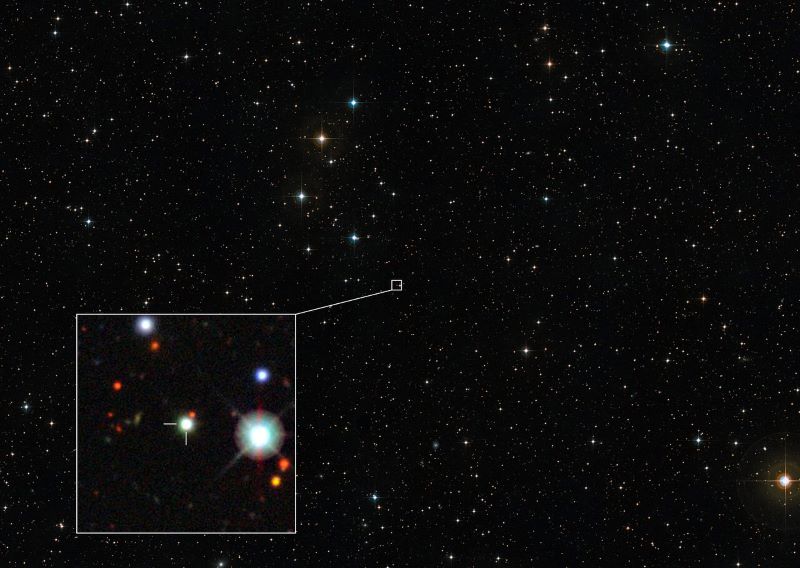- Despite being visible in sky surveys since 1980, only last year did scientists identify this record-breaking quasar, J0529-4351.
- Quasar J0529-4351 is the most luminous object in the known universe, with a mass of 17 billion suns and consuming over a solar mass per day.
- The quasar also holds the title for fastest-growing black hole and is home to the largest known accretion disk.
Record quasar was hiding in plain sight
The most luminous known object in the universe has been hiding in plain sight for decades. The newly identified object – a quasar, or the bright core of a galaxy powered by a black hole – showed up on the ESO Schmidt Southern Sky Survey in 1980. It was so bright that it was originally miscategorized as a foreground star. ESO said on February 19, 2024, that the quasar – named J0529-4351 – is both the most luminous object known to date and the fastest-growing black hole currently known. That’s because, as a general rule, the most luminous quasars indicate the fastest-growing supermassive black holes.
Researchers published a study on the quasar in the peer-reviewed journal Nature Astronomy on February 19, 2024. Lead author Christian Wolf of the Australian National University (ANU) said:
We have discovered the fastest-growing black hole known to date. It has a mass of 17 billion suns, and eats just over a sun per day. This makes it the most luminous object in the known universe.
Co-author Christopher Onken, also of ANU, discussed its surprise discovery:
It is a surprise that it has remained unknown until today, when we already know about a million less impressive quasars. It has literally been staring us in the face until now.
EarthSky lunar calendars are back in stock! And we’re guaranteed to sell out, so get one while you can. Your support means the world to us and allows us to keep going. Purchase here.
Largest accretion disk in the universe
Quasars are so bright because they’re powered by supermassive black holes at the cores of galaxies. The black holes collect matter from their surroundings, producing energy that they emit as vast amounts of light. Quasars are so bright that telescopes can pick up even very distant ones from Earth. And Quasar J0529-4351 is so far away from Earth that its light took more than 12 billion years to reach us.
The matter this black hole sucks in forms a disk – known as an accretion disk – and emits energy. In fact, J0529-4351 emits so much energy it’s over 500 trillion times more luminous than the sun. ANU Ph.D. student and co-author Samuel Lai said:
All this light comes from a hot accretion disc that measures seven light-years in diameter. This must be the largest accretion disc in the universe.
For a sense of scale, the quasar’s accretion disk would be about 15,000 times the distance from the sun to Neptune.
Hiding in plain sight
Sky surveys that scan huge swaths of the sky accumulate so much data that researchers use machine-learning models to analyze it all. However, these models learn from existing data. So a new, record-breakingly-bright quasar from a distant galaxy might get classified as a star in our own galaxy. And that’s exactly what first happened with J0529-4351.
Only last year did researchers recognize it as a distant quasar by using observations from the ANU 2.3-meter telescope at the Siding Spring Observatory in Australia. And researchers needed an even larger telescope to discover it was the most luminous quasar yet seen. For that, they used the X-shooter spectrograph on ESO’s VLT in the Chilean Atacama Desert to get more precise measurements, revealing the quasar’s true nature.
As researchers learn more about the quasar, it could open up insights on the early universe, such as how quasars and host galaxies formed and evolved. But Wolf said:
Personally, I simply like the chase. For a few minutes a day, I get to feel like a child again, playing treasure hunt, and now I bring everything to the table that I have learned since.

Bottom line: The record quasar J0529-4351 is the current title holder for most luminous object in the universe, fastest-growing black hole in the universe and largest accretion disk in the universe.
Source: The accretion of a solar mass per day by a 17-billion solar mass black hole
Via ESO